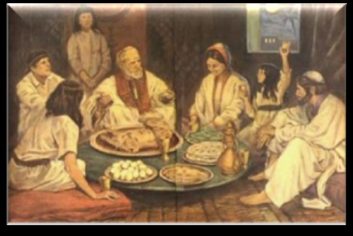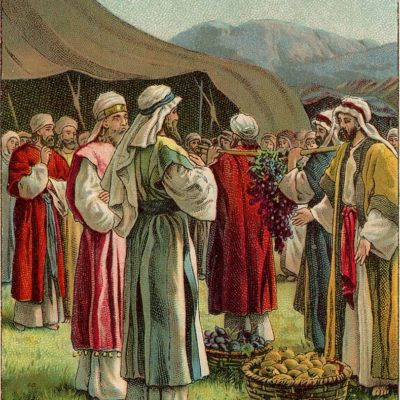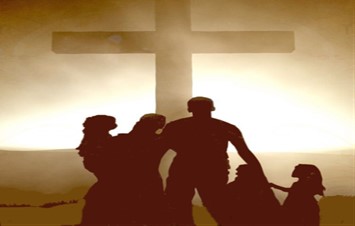First Century Galilee Jewish Tradition

First century Galilee Jewish Tradition can give us an insightful understanding of the New Testament women.
It is believed that Mary lived in the first century in Galilee. Looking at the tradition of their period we can gain an insightful look at the times of Mary and better understand her. The family was the basic unit of this society. The family usually had the same religious observances. Mary’s family would be following the Jewish religion. The term family would consist of the entire household of husband, wife, children, any other elderly relatives and the slaves they held.
The first tradition we will look at is Jewish marriages. Jewish marriage took place in three phases over a long period of time. When the couple was still very young, an Engagement was arranged by the parents or nearest relative. Older people might use the help from a matchmaker. Usually it was a contract between different families. This was the first phase.
The father of the bride and the father of the groom would customary discuss the proposal of the marriage. This would include the price that would be offered by the groom for the bride. If the father of the bride agreed to the proposed price then the two men would seal the agreement with a toast of wine. A written contract listed the time, place, and size of the wedding as well as recording the dowry and terms of maintenance of the marriage. This binding document called a “ketubah” was kept in the bride’s possession until the consummation of the marriage. Finally, this first part of a two-part ceremony was concluded by the toast of a glass of wine. The whole ceremony was called the “Shiddukhin,” or engagement.
The second phase was the Betrothal ceremony. This was generally held at the home of the bride’s parents. The couple exchanged vows and the groom gave the bride presents. This period could last up to one or two years. The bride and groom were chaperoned and the bride remained living with her parents. This is the term we find with the story of Mary and Joseph. Mary was “espoused” to the Joseph. This can be found in Matthew 1:18; Luke 1:27; Luke 2:5.
The Marriage Supper came next. It usually happened at night. The bride would be prepared by bathing, then anointing, and clothing all with special adornments. The groom and his friends came to the home of the bride. She would be wearing a thick veil. She and her friends would accompany the groom and his friends to the home of the groom’s father. This could have been held at a relative’s house depending on the size of the wedding party. There was always music and great festivities. This is when the contract was signed.
The bride and groom would spend time together, and then the bride would remain by herself for seven days. The bride would return to the group at the end of the week, remove her veil so that everyone could see her. If the young woman had never been married, the feast would last for seven days. If she were a widow remarrying, it would last for three days.
Because of the heavy veil that was worn for such a long period of time one can understand why Jacob was tricked by Laban into marring Leah, and then had to work seven more years for Rachel. (Genesis 29:1-30).
We learned from the first miracle that Jesus performed at the Wedding at Cana of Galilee that there was wine served. The festivities of the wedding probably began on the third day. (John 2:1-11). The men guests would recline to eat on floor mats. There were lots of food consumed, wine flowed, and lots of music and dancing.
Wedding food in first century in Galilee was as important as it is today for us. Their food would have been kosher food and played an important part to their faith and their culture. Tradition suggests that the wedding feast might include roasted lamb and goats were reserved for festivals and sacrificial feasts. Fish was always available depending where they lived. Bread was served at every meal. Figs and grapes were the most commonly eaten fruits. Pomegranates and dates also were common to eat.
The duties of the married wife would have been to look after her husband. The wife had to obey her husband, mill the grain, do any gardening, cook, wash the clothes, clean the house, and take care of the children or anything else that her husband needed done. Only the husband could bring a rite of divorce; but then he would have to return the woman dowry and anything that was in the contract of the original marriage decree.
The husband had to provide his wife clothes and lodging and make sure she had whatever her need to perform her household duties. If she was to get ill it was the husband’s responsibility to get her medicine. The husband also had to provide a tomb for her to be buried. It is said that even the very poor husband had to obtain at least two flute players and someone to wail at her funeral.
It was the duty of the wife to provide a breakfast of curds and bread for the family who was usually up at sunrise for farm duties. It was the women who would go to the well in the village to get fresh water for the family daily needs. The Old Testament and New Testament both substantiate the carrying of water in heavy pots and carry the fresh water on their shoulders or o their heads. We also know the well was the center of the village life where information was received and spread.
Women and especially those with children have always had the responsibility of watching the children and household chores. The flat roofed brick houses were probably hard to keep clean even though they were usually only one room. The door opened directly on the streets. There was usually a small courtyard where the women would gather and do laundry, cook over the wood fires, and where the children would play under the supervision and watchful eyes of the women of the village. The animals also shared the courtyard such as sheep and goats were raised for their milk, wool and meat. Cheese would be made from the curds of goat’s milk. The chickens also shared the courtyard and were kept for their eggs and meat.
Deuteronomy 22:8 tells us there was a wooden ladder that led to the roof and had parapet, which is a low wall at the edge of a balcony. There the clothes could dry and in the hot summer months the family might eat and sleep there.
Barley had to be grind between millstones so the bread could be made and baked for the family. There meals were simple but generous with a variety of vegetables to eat such as onions, leeks, cucumbers even beans and lentils. The meat were usually dried such as salted fish or boiled chicken even goat meat. The fruits would be used as a dessert you would find grapes, figs, pomegranates a variety of melons and nuts and we know John the Baptist ate locus and wild honey.
Mothers did the education for the young Jewish girls since there were not regular schoolings. Young girls were taught how to be good wives and mothers. It was important to know the Jewish laws and traditions especially when it pertained to the dietary laws for Sabbath and the Passover or other special holidays. Mothers also taught their roles as women in the customs and tradition behind the Sabbath, Passover, Purim, and other holidays. The mothers had to teach their daughters to master of spinning and weaving cloths and turning it into garments to wear. Young girls also had to learn the herbal uses of medical remedies for treating illnesses. The delivery of babies also was an important skill that had to be taught by the mothers.
Women had many responsibilities in the first century in Galilee. These responsibilities are not being performed in the modern day times as they use to be. It is true that our lives in the modern era have changed. This is partly because of the electric appliances that has replaced many of the mundane tasks and made life easier for the women of today. Stores provide clothes so dressmaking and sewing is a thing of the past. Fast food has made learning how to cook old-fashioned. The discovery in the medical world has made learning about herbs treatments obsolete and Obstetrician has made delivering babies a things of the past.
References:
Bank, R.D. (2005). 101 Things Everyone Should Know About Judaism. Avon, Massachusetts. Adams Media.
Ferguson, E. (1991). Backgrounds of Early Christianity. Indiana. Reader’s Digest.
H. S. Stuttman Co., Inc. (1968). The Living Bible Encyclopedia in Story and Pictures. New York, New York. Zondervan Publishing House.
Pfeiffer, C.F., Vos, H. F., & Rea J. (1975). The Wycliffe Bible Encyclopedia. Chicago, Moody Press.
Cite Article Source
MLA Style Citation:
Holstein, Joanne “First Century Galilee Jewish Tradition:.” Becker Bible Studies Library Jan 2015.< https://guidedbiblestudies.com/?p=1931,>.
APA Style Citation:
Holstein, Joanne (2015, January) “First Century Galilee Jewish Tradition:.” Becker Bible Studies Library. Retrieved from https://guidedbiblestudies.com/?p=1931,.
Chicago Style Citation:
Holstein, Joanne (2015) “First Century Galilee Jewish Tradition:.” Becker Bible Studies Library (January), https://guidedbiblestudies.com/?p=1931, (accessed).


